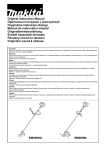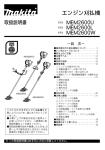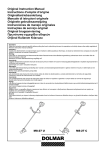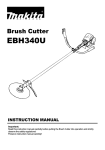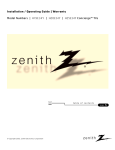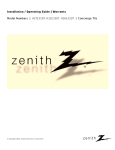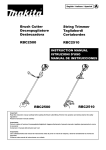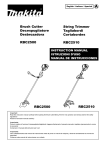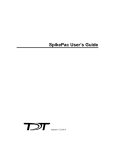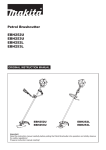Download Makita EM2600U Instruction manual
Transcript
Brush Cutter/String Trimmer EM2600U EM2600L ORIGINAL INSTRUCTION MANUAL EM2600U EM2600L Important: Read this instruction manual carefully before putting the brush cutter/string trimmer into operation and strictly observe the safety regulations! Preserve instruction manual carefully! English Thank you for purchasing this MAKITA brush cutter/string trimmer. MAKITA brush cutters/string trimmers are developed as a product of our many years of knowledge, experience, and a detailed development programme. Please read this booklet thoroughly to ensure you gain the best possible performance and outstanding results that your MAKITA brush cutter/string trimmer can provide. Table of Contents Symbols You need to note the following symbols when reading the instructions manual. Read instruction Manual Wear eye and ear protection (for string trimmer only) Take Particular care and Attention Wear protective helmet, eye and ear protection (for brush cutter only) Forbidden Do not use metal blades (for string trimmer only) Keep your distance Maximum permissible tool speed Flying object hazard Hot surfaces - Burns to fingers or hands No Smoking Fuel and oil mixture No open flames Engine-Manual start Protective gloves must be worn Emergency stop Kickback First Aid Keep the area of operation clear of all persons and animals ON/START Wear sturdy boots with nonslip soles. Steeltoed safety boots are recommended. OFF/STOP START 2 Page Symbols ........................................................................ 2 Safety instructions......................................................... 3 Technical data............................................................... 7 Names of parts.............................................................. 8 Mounting the handle ..................................................... 9 Mounting the protector ................................................ 10 Mounting the cutter blade/nylon cutting head ............. 11 Fuel/Refuelling ............................................................ 12 Correct handling.......................................................... 13 Important operating points/stopping the cutter/ trimmer ........................................................................ 13 Resharpening the cutting tool ..................................... 15 Servicing instructions .................................................. 17 Storage ....................................................................... 19 Safety instructions General Instructions – To ensure correct operation, make sure that you read and fully understand this instruction manual to familiarise yourself with how to use the brush cutter/ string trimmer. Using this equipment without understanding how to operate it correctly may result in serious injury to yourself or others. – Only lend the brush cutter/string trimmer to people who have proved experienced with brush cutter/string trimmers. Always lend them this instruction manual at the same time. – If this is your first time using an engine powered cutter, consult your dealer for basic instructions. – Children and young persons aged under 18 years must not be allowed to operate the brush cutter/string trimmer. Persons over the age of 16 years may use the device for training purposes, only whilst under supervision of a qualified trainer. – Use brush cutter/string trimmers with the utmost care and attention. – Only operate the brush cutter/string trimmer if you are in good physical condition. Perform all work calmly and carefully. Users must accept responsibility for those around them. – Never use the brush cutter/string trimmer after consumption of alcohol or medicines, or if you are feeling tired or ill. WARNING: This machine produces an electromagnetic field during operation. This field may under some circumstances interfere with active or passive medical implants. To reduce the risk of serious or fatal injury, we recommend persons with medical implants to consult their physician and the medical implant manufacturer before operating this machine. Intended use of the equipment – The brush cutter/string trimmer is only intended for cutting grass, weeds, bush and other such undergrowth, and should not be used for any other purpose such as edging or hedge cutting as this may cause injury. Personal protective equipment (1) – Always wear clothing that is both functional and appropriate to your work, i.e. tight-fitting, but not so tight as to cause uncomfortable movement. Do not wear either jewelry or clothing which could become entangled with bushes or shrubs. – In order to avoid head, eye, hand, or foot injuries, as well as to protect your hearing during operation, the following protective equipment and protective clothing must be used while using the brush cutter/string trimmer. – Always wear a helmet where there is a risk of falling objects. The protective helmet (1) is to be checked at regular intervals for damage and is to be replaced at the latest after 5 years. Use only approved protective helmets. – The visor (2) of the helmet (or alternatively goggles) protects the face from flying debris and stones. During operation of the brush cutter/string trimmer, always wear goggles or a visor to prevent eye injuries. – Wear adequate noise protection equipment to avoid hearing impairment (ear muffs (3), ear plugs etc.). – Work overalls (4) protect against flying stones and debris. We strongly recommend that you wear work overalls. – Special gloves (5) made of thick leather are part of the prescribed equipment and must always be worn during operation of the brush cutter/string trimmer. – When using the brush cutter/string trimmer, always wear sturdy shoes (6) with a non-slip sole. Such shoes protect against injuries and ensure good footing. (2) (3) (4) (5) Residual risks – Even when the machine is used as prescribed it is not possible to eliminate all residual risk factors. The following hazards may arise in connection with the machine’s construction and design: 1. Damage to lungs if an effective dust mask is not worn. 2. Damage to hearing if effective hearing protection is not worn. 3. Damages to health resulting from vibration emission if the machine is being used over longer period of time or not adequately managed and properly maintained. Diagram Starting the brush cutter – Make sure that there are no children or other people within a working range of 15 meters (50ft), also pay attention to any animals in the working vicinity. – Before use, always check that the brush cutter/string trimmer is safe for operation: Check that the cutting tool is secure, that the control lever can be operated easily, and that the control lever lock is functioning correctly. – Rotation of the cutting tool during idling is prohibited. Check with your dealer if you think the equipment may need adjusting. Check to make sure that the handles are clean and dry, and that the start/stop switch is functioning correctly. 3 15 meters (6) – Start the brush cutter/string trimmer only in accordance with the instructions. Do not use any other methods to start the engine! – Only use the brush cutter/string trimmer and tools for the specified purposes. – Only start the brush cutter/string trimmer engine after the equipment is fully assembled. Do not operate the equipment until all of the appropriate accessories are attached! – Before starting, make sure that the cutting tool is not in contact with hard objects such as branches, stones etc. as the cutting tool will rotate when starting. – Switch off the engine immediately if any type of engine problem occurs. – Should the cutting tool hit stones or other hard objects, immediately switch off the engine and inspect the cutting tool. – Inspect the cutting tool at short regular intervals for damage (inspect for hairline cracks using the tapping test). – Only operate the brush cutter/string trimmer after attaching and adjusting the shoulder strap to the correct length. The shoulder strap must be adjusted to the user’s size and fastened to prevent fatigue during operation of the equipment. Never hold the cutter with one hand during operation. – During operation, always hold the brush cutter/string trimmer with both hands. Always ensure you are on safe footing. – Operate the brush cutter/string trimmer in such a manner as to avoid inhalation of the exhaust gases. Never run the engine in an enclosed space such as inside a room (risk of gas poisoning). Carbon monoxide is an odorless gas. – Always switch off the engine when resting, or if you intend to leave the brush cutter/string trimmer unattended, and place it in a safe location to prevent injury to other people and damage to the equipment. – Never put the hot brush cutter/string trimmer onto dry grass or onto any other combustible materials. – The cutting tool must always be equipped with the appropriate guard. Never run the cutter without this guard! – All protective installations and guards supplied with the equipment must be used during operation. – Never operate the engine if the exhaust muffler is faulty. – Shut off the engine during transport. – When transporting the equipment, always attach the cover to the cutting blade. – Ensure the brush cutter/string trimmer is positioned safely during transport to avoid fuel leakage. – When transporting the brush cutter/string trimmer, ensure the fuel tank is completely empty. – When unloading the brush cutter/string trimmer from a truck or other such vehicle, never drop the engine to the ground, as doing so may severely damage the fuel tank. – Unless in an emergency, never drop or cast the brush cutter/string trimmer to the ground as doing so may severely damage the brush cutter/string trimmer. – Always lift the entire equipment from the ground when moving it. Dragging the equipment on its fuel tank is extremely dangerous and may cause fuel to leak, which may cause fire. – If the equipment gets heavy impact or fall, check the condition before continuing work. Check the fuel system for fuel leakage and the controls and safety devices for malfunction. If there is any damage or doubt, ask our authorized service center for the inspection and repair. Refuelling – Shut off the engine during refuelling, keep away from open flames and do not smoke during refuelling. – Ensure mineral oil products do not come into contact with skin. Do not inhale the fuel vapor. Always wear protective gloves during refuelling. Change and clean protective clothing at regular intervals. – To prevent soil contamination (environmental protection), make sure you do not spill fuel or oil on the ground. If you do spill fuel, clean the brush cutter/ string trimmer immediately. – Make sure fuel does not come into contact with your clothing. If fuel does come into contact with your clothing, change your clothing immediately to prevent fire. – Inspect the fuel cap at regular intervals to make sure that it can be securely fastened and does not leak. – Carefully tighten the fuel tank cap. Once refuelling is complete, move to a location at least 3 meters away from where you refuelled before starting the engine. – Never refuel in an enclosed space such as inside a room. Doing so may cause an explosion due to the accumulation of fuel vapor at ground level. 4 • • • • • Resting Transport Refuelling Maintenance Tool Replacement – Only transport and store fuel in approved containers. Make sure stored fuel is not accessible to children. Method of operation – Only use the brush cutter/string trimmer in good light and visibility. During the winter season, beware of slippery or wet areas such as icy or snow-covered areas (risk of slipping). Always ensure you are on safe footing. – Never cut above waist height. – Never stand on a ladder while using the brush cutter/string trimmer. – Never climb up into trees to use with the brush cutter/string trimmer. – Never work on unstable surfaces. – Remove sand, stones, nails etc. found within the working range. Foreign objects may damage the cutting tool and can cause dangerous kickbacks. – Before starting to cut, make sure the cutting tool has reached full working speed. – If grass or branches get caught between the cutting tool and guard, always stop the engine before cleaning. Otherwise unintentional blade rotation may cause serious injury. – Take a rest to prevent loss of control caused by fatigue. We recommend to take a 10 to 20-minute rest every hour. Kickback (blade thrust) – When operating the brush cutter, uncontrolled kickbacks may occur. – Kickbacks occur frequently when attempting to cut with the 12 to 2 o’clock section of the blade. – Never apply the 12 to 2 o’clock section of the brush cutter blade. – Never apply this section of the brush cutter blade to solid objects, such as bushes or trees etc. that have a diameter greater than 3 cm. Doing so will cause the brush cutter to deflect with a large amount of force, which is extremely dangerous and may cause injury. Caution: Kickback Diagram Kickback prevention To avoid kickbacks, remember the following: – Using the 12 to 2 o’clock section of the blade is extremely hazardous, especially when using metal cutting tools. – Cutting operations using the 11 to 12 o’clock section and 2 to 5 o’clock section of the blade must only be performed by trained and experienced operators, and then only at their own risk. The optimum cutting section for easy cutting with almost no kickback is between the 8 to 11 o’clock section of the blade. Cutting Tools – Use an applicable cutting tool for the job in hand. Nylon cutting heads (string trimmer heads) are suitable for trimming lawn grass. Metal blades are suitable for cutting weeds, high grasses, bushes, shrubs, underwood, thicket, and the like. Never use other blades including metal multi-piece pivoting chains and flail blades. Otherwise serious injury may result. – When using metal blades, avoid “kickback” and always prepare for an accidental kickback. See the section “Kickback” and “Kickback prevention”. Maintenance instructions – Have your equipment serviced by our authorized service center, always using only genuine replacement parts. Incorrect repair and poor maintenance can shorten the life of the equipment and increase the risk of accidents. – Always check the condition of the cutter, in particular the cutter protective devices and shoulder strap, before commencing work. Particular attention should also be paid to the cutting blades, which must be correctly sharpened. – Turn off the engine and remove the spark plug connector when replacing or sharpening cutting tools, and also when cleaning the cutter or cutting tool. 5 Diagram Never straighten or weld damaged cutting tools. – Operate the brush cutter/string trimmer with as little noise and contamination as possible. In particular, check that the carburetor is set correctly. – Clean the brush cutter/string trimmer at regular intervals and check that all screws and nuts are well tightened. – Never service or store the brush cutter/string trimmer in the vicinity of naked flames. – Always store the brush cutter/string trimmer in locked rooms and with an emptied fuel tank. – When cleaning, servicing and storing the equipment, always attach the cover to the cutting blade. Observe the relevant accident prevention instructions issued by the relevant trade associations and insurance companies. Do not perform any modifications on the brush cutter/string trimmer, as doing so will endanger your safety. The performance of maintenance or repair work by the user is limited to those activities described in the instruction manual. All other work is to be done by an Authorized Service Agent. Use only genuine spare parts and accessories released and supplied by MAKITA. Using non-approved accessories and tools will cause an increased risk of accidents. MAKITA will not accept any liability for accidents or damage caused by the use of non-approved cutting tools, fixing devices of cutting tools, or accessories. First Aid In case of accident, make sure that a first-aid box is available in the vicinity of the cutting operations. Immediately replace any item taken from the first aid box. When asking for help, please give the following information: – – – – – Place of the accident What happened Number of injured persons Kind of injuries Your name Vibration – People with poor circulation who are exposed to excessive vibration may experience injury to blood vessels or the nervous system. Vibration may cause the following symptoms to occur in the fingers, hands or wrists: “Falling asleep” (numbness), tingling, pain, stabbing sensation, alteration of skin color or of the skin. If any of these symptoms occur, see a physician! – To reduce the risk of “white finger disease”, keep your hands warm during operation and well maintain the equipment and accessories. For European countries only EC Declaration of Conformity We Makita Corporation as the responsible manufacturer declare that the following Makita machine(s): Designation of Machine: Brush Cutter/String Trimmer Model No./ Type: EM2600U, EM2600L Specifications: see “TECHNICAL DATA” table are of series production and Conforms to the following European Directives: 2000/14/EC, 2006/42/EC, 2004/108/EC And are manufactured in accordance with the following standards or standardized documents: EN ISO 11806-1, EN ISO 14982 The technical documentation is kept by: Makita International Europe Ltd., Technical Department, Michigan Drive, Tongwell, Milton Keynes, Bucks MK15 8JD, England The conformity assessment procedure required by Directive 2000/14/EC was in Accordance with annex V. Measured Sound Power Level (as a grass trimmer): 109.77 dB Measured Sound Power Level (as a brush cutter): 107.29 dB Guaranteed Sound Power Level: 112 dB 15. 4. 2013 Tomoyasu Kato Director Makita Corporation 3-11-8, Sumiyoshi-cho, Anjo, Aichi, JAPAN 6 Technical data Model Dimensions: length x width x height (without cutting blade) Net Weight EM2600U EM2600L U handle Loop handle 1,770 x 610 x 410 mm 1,770 x 330 x 185 mm 5 kg 5 kg Engine displacement 25.7 cm3 Maximum engine performance 0.83 kW 8,800 min-1 Maximum rotational frequency of the spindle Single piece metal blade φ230 mm String trimmer head φ430 mm Cutting attachment Idling speed 3,000/min Clutch engagement speed 4,100/min Gear ratio 14/19 Mixed gas Gasoline: Two-stroke Engine Oil = 50:1 Fuel Volume (fuel tank) 0.6 L Carburetor WALBRO WYC Spark plug NGK BPMR7A Electrode gap 0.6 - 0.7 mm Left handle (Front grip) 14.680 m/s2 K = 1.5 m/s2 5.152 m/s2 K = 1.5 m/s2 Right handle (Rear grip) 9.037 m/s2 K = 1.5 m/s2 9.677 m/s2 K = 1.5 m/s2 Left handle (Front grip) 7.961 m/s2 K = 1.5 m/s2 8.83 m/s2 K = 1.5 m/s2 Right handle (Front grip) 7.019 m/s2 K = 1.5 m/s2 14.381 m/s2 K = 1.5 m/s2 Vibration: (For brush cutter) Vibration: (For grass trimmer) Noise (tested according to 2000/14/EC & 2005/88/EC): Sound pressure level at the operator’s position (Grass trimmer): 98.52 dB (A) K = 2.5 dB (A) Sound pressure level at the operator’s position (Brush cutter): 96.15 dB (A) K = 2.5 dB (A) Measured sound power level (Grass trimmer): 109.77 dB (A) K =2.5 dB (A) Measured sound power level (Brush cutter): 107.29 dB (A) K = 2.5 dB (A) Noise (tested according to 2000/14/EC & 2005/88/EC): guaranteed sound power values 112 dB (A) 7 Names of parts EM2600U U Handle Type EM2600L Loop Handle Type (3) (7) (19) Names of parts (21) (1) 8 1 Fuel Tank 2 Rewind Starter 3 Air Cleaner 4 I-Stop Switch (on/off)/Start-Stop Switch 5 Spark Plug 6 Exhaust Muffler 7 Clutch Case 8 Rear Grip 9 Hanger 10 Handle 11 Control Lever 12 Control Cable 13 Shaft 14 Protector (Cutting tool guard) 15 Gear Case 16 Handle Holder 17 Cutter Blade 18 Nylon Cutting Head 19 Fuel Filler Cap 20 Starter Knob 21 Primer Pump 22 Choke Lever Mounting the handle CAUTION: Before doing any work on the brush cutter, always stop the engine and disconnect the spark plug connector from the spark plug. Always wear protective gloves! CAUTION: Ensure you have reassembled the brush cutter completely before starting it. For U handle models – Place the two handles onto the handle holder. The control lever must come right side when you look towards the cutting tool. – Fit the handle ends to the groove on the handle holder and fit the clamp on them. Loosely tighten them with four bolts for adjustment. – Adjust handles’ angle, and then tighten all bolts evenly by a hex wrench. L R – Place the throttle cable (1) to the control lever side of the shaft. And then wrap them with the waist pad (2). EM2600U (2) (1) EM2600U – Insert the throttle cable (1) into the clamping slot (3) of the handle holder. – Make sure the throttle cable is positioned as shown. – Operate the control lever and make sure it moves smoothly. (3) (1) EM2600U CAUTION: Do not position the throttle cable as shown. Otherwise curved cable may cause high idle speed, and uncontrollable blade may cause personal injury. EM2600U 9 For loop handle model – Put the thread (1) on handle holder into the location hole (2) on tube. – Fix the assistant handle (3) onto the barrier. – Tighten the 4 bolts (4) M5 x 30. (4) (2) (1) (3) Engine Engine EM2600L Mounting the protector To meet the applicable safety standards, you must only use the tool/protector combinations indicated in the table. Always use genuine MAKITA cutter blades/nylon cutting head. – The cutter blade must be well polished, and free of cracks or breakages. If the cutter blade hits against a stone during operation, stop the engine and check the blade immediately. – Polish or replace the cutter blade every three hours of operation. – If the nylon cutting head hits against a stone during operation, stop the engine and check the nylon cutting head immediately. Star Blade Protector for metal blades Nylon cutting head Protector for cord cutter CAUTION: The appropriate protectors must always be installed for your own safety and in order to comply with accident-prevention regulations. Operation of the equipment without the guard installed is prohibited. – Fix the protector (1) to the clamp (3) with two M6 x 30 bolts (2). (2) (3) (1) – When using the nylon cutting head, fit the protector (5) into the protector (1), and tighten them with two screws (4). 10 Mounting the cutter blade/nylon cutting head The cutter blade or nylon cutting head can be replaced easily by first turning the equipment upside down. – Insert the hex wrench through the hole in the gear case and rotate the receiver washer (3) until it is locked with the hex wrench. – Loosen the nut/spring washer (1) (left-hand thread) with the socket wrench, and remove the nut/spring washer (1) and clamp washer (2). (2) (1) (3) With the hex wrench still in place – Mount the cutter blade onto the shaft so that the guide of the receiver washer (3) fits in the arbor hole in the cutter blade. Install the clamp washer (2) and secure the cutter blade with the nut/spring washer (1). [Tightening torque: 13 - 23 N-m] Tighten Loosen NOTE: Always wear gloves when handling the cutter blade. NOTE: The cutter blade-fastening nut (with spring washer) is a consumable part. If there appears any wear or deformation on the spring washer, replace the nut. Hex wrench NOTE: The clamp washer (2), and nut/spring washer (1) are not necessary for mounting the nylon cutting head. The nylon head should go on top of the receiver washer (3). – Screw the nylon cutting head onto the shaft. Tighten Loosen Hex wrench – Make sure that the blade rotates counterclockwise. Rotation 11 Fuel/Refuelling Handling fuel Utmost care is required when handling fuel. Fuel may contain substances similar to solvents. Refuel either in a well ventilated room or outdoors. Do not inhale fuel vapors, and avoid any contact of fuel or oil with your skin. Mineral oil products degrease your skin. Prolonged skin contact with these products will cause your skin to become extremely dry, which may result in various kinds of skin disease. In addition, allergic reactions may occur. Eyes can be irritated by contact with oil. If oil comes into your eyes, immediately wash them with clear water. If your eyes are still irritated, see a doctor immediately. Observe the Safety Instructions on page 3. Fuel and oil mixture The brush cutter engine is a high-efficiency two-stroke engine. It runs on a mixture of fuel and two-stroke engine oil. The engine is designed for unleaded regular fuel with a min. octane value of 91 RON. To obtain optimum engine performance and to protect your health and the environment, use only unleaded fuel! To lubricate the engine, add two-stroke engine oil (quality grade: JASO FC or ISO EGD) to the fuel. The engine has been designed to use the specified twostroke engine oil at mixture ratio of 50:1 to protect the environment. Additionally, long service life accompanied by reliable operation and minimum emissions are guaranteed through the use of this mixture ratio. Reliable functioning of the brush cutter cannot be guaranteed unless this mixture ratio of 50:1 (specified 2-stroke engine oil) is strictly observed. Correct mixture ratio: Gasoline: Specified two-stroke engine oil = 50 : 1 or Gasoline: Other manufacturer’s two-stroke engine oil = 25 : 1 recommended NOTE: To prepare the fuel-oil mixture, first mix the entire oil quantity with half of the fuel required, then add the remaining fuel. Thoroughly shake the mixture before pouring it into the brush cutter tank. To ensure safe operation, do not add more engine oil than the specified amount. Doing so will only result in a higher production of combustion residues which pollute the environment and clog the exhaust channel in the cylinder as well as the muffler. In addition, the fuel consumption will rise and the performance will decrease. Refuelling The engine must be switched off. – Thoroughly clean the area around the fuel filler cap (2) to prevent dirt from getting into the fuel tank (1). – Unscrew the fuel filler cap (2) and fill the tank with fuel. – Tightly screw on the fuel filler cap (2). – Clean the screw fuel filler cap (2) and tank after refueling. Storage of Fuel Fuel cannot be stored for an unlimited period of time. Purchase only the quantity required for a 4-week operating period. Only use approved fuel storage containers. 12 Gasoline 50:1 25:1 20 cm3 100 cm3 200 cm3 40 cm3 200 cm3 400 cm3 + 1,000 cm3 (1 liter) 5,000 cm3 (5 liter) 10,000 cm3 (10 liter) Correct handling Attachment of shoulder strap – Adjust the strap length so that the cutter blade is kept parallel with the ground. Detachment – In case of emergency, push the notches (1) at both sides, and detach the equipment. Be extremely careful to maintain control of the equipment at this time. Do not allow the equipment to be deflected toward you or anyone in your vicinity. WARNING: Failure to maintain complete control of the machine at all could result in serious injury or DEATH. Note: In some countries, shoulder strap does not have this detachment function. (1) Hanger Important operating points/stopping the cutter/trimmer Observe the applicable accident prevention regulations. Starting Move at least 3 m away from the area where you refuelled the equipment. Place the brush cutter on a clean piece of ground taking care that the cutting tool does not come into contact with the ground or any other objects. WARNING: Pay attention that the cutting tool rotates immediately after the engine starts. (1) (4) Cold start for U handle models – – – – Set the I-Stop Switch (on/off) (1) as illustrated. Grasp the handle (hand pressure activates the safety lock-off lever (2)). Press the throttle lever (3) and hold it down. Press the lock button (4) and release the control lever, and then release the lock button (the lock button holds the throttle lever in the start-up position). (3) (2) EM2600U Cold start for loop handle models – – – – Set the Start-Stop Switch (1) to start position as illustrated. Grasp the handle (hand pressure activates the safety lock-off lever (2)). Press the throttle lever (3) and hold it down. Set the Start-Stop Switch (1) to start position and release the control lever, and then release the Start-Stop Switch (the Start-Stop Switch holds the throttle lever in the start-up position). (2) (3) (1) 13 EM2600L Warm start for U handle models – Set the I-Stop Switch (on/off) (1) as illustrated. EM2600U Warm start for loop handle models – Set the Start-Stop Switch (1) to neutral position as illustrated. EM2600L – First, place the equipment on the ground. – Gently press the primer pump (5) repeatedly (7-10 times) until fuel comes into the primer pump. – Close the choke lever (6). Choke opening: • Fully closed in cold temperatures or when the engine is cold • Fully or half open for restart while the engine is still warm (6) CLOSE (5) – Firmly hold the clutch case with your left hand, as illustrated. – Slowly pull the starter grip until you feel resistance, and then continue to pull sharply. – Do not pull out the starter rope to its full extent, and do not allow the starter handle to retract by itself. Maintain control of the starter rope and ensure it retracts slowly. – Repeat the starting operation until you hear the engine’s initial ignitions. – Depress the choke lever (6) ( ) and pull the starter rope again until the engine starts. – As soon as the engine starts, immediately tap and release the throttle, to release the half-throttle lock and allow the engine to idle. – Run the engine for approximately one minute at a moderate speed before applying full throttle. OPEN (6) (5) NOTE: – If you pull the starter handle repeatedly when the choke lever is in the at “ ” position, the engine will not start easily due to excessive fuel intake. – If excessive fuel intake occurs, remove the spark plug and pull the starter handle slowly to remove excess fuel. Also, dry the electrode section of the spark plug. 14 Caution during operation: If the throttle lever is opened fully during a no-load operation, the engine revolutions increase over 10,000 min-1. Never operate the engine at a higher speed than required, and keep the revolutions at an approximate speed of 6,000 - 8,000 min-1. CAUTION: Always reduce the engine revolutions when the equipment is not being used for work. Operating the equipment at high revolutions when not being used for work will shorten the lifespan of the equipment. Stopping – Release the throttle lever (3) fully, and when the engine rpm has lowered, push the I-Stop Switch (on/off)/Start-Stop Switch (1) to “STOP” position to stop the engine. – Be aware that the cutting head may not stop immediately, and always allow it to slow down and stop fully by itself. EM2600U EM2600L Resharpening the cutting tool CAUTION: The cutting tools listed below must only be resharpened by an authorized facility. Manual resharpening will result in imbalances of the cutting tool, which will cause vibrations and damage to the equipment. – cutter blade (star blade (4 teeth)) A professional resharpening and balancing service is provided by Authorized Service Agents. NOTE: To increase the service life of the cutter blade (star blade) the blade may be turned over to allow both cutting edges to wear. 15 NYLON CUTTING HEAD Most effective cutting area The nylon cutting head is a dual line trimmer head that has bump & feed mechanism. The nylon cutting head feeds out the nylon cord after tapping the trimmer head on the ground. Operation – The most effective cutting area is shown by the shaded area. – To feed the nylon cord, increase the nylon cutting head speed to approx. 6,000 min-1 and tap the nylon cutting head lightly on the ground. – If the nylon cutting head does not feed out by tapping, rewind/replace the nylon cord by following the procedures described under “Replacing the nylon cord.” Replacing the nylon cord – Stop the engine. – Press the housing latches inward to lift off the cover, then remove the spool. Cover Latches Press Press – Hook the center of new nylon cord into the notch in the center of the spool, with one end of the cord extending about 80 mm (3-1/8”) more than the other. Then wind both ends firmly around the spool in the direction of the head rotation (left-hand direction indicated by LH and right-hand direction by RH on the side of the spool). Spool 80 mm (3-1/8”) Spool For left hand rotation – Wind all but about 150 mm (6”) of the cords around the spool, leaving the ends temporarily hooked through the notch on the side of the spool. 150 mm (6”) Notches 16 – Feed the cords through the eyelets to come out of the housing. Mount the washer, spring, and spool in the housing. Eyelet – Align the hooks on the the cover and the housing. Then push cover firmly onto the housing to secure it. Cover Hook Hook Eyelet Servicing instructions Servicing instructions CAUTION: Before performing any type of maintenance work on the brush cutter, always switch off the motor and detach the plug cap from the spark plug (see “checking the spark plug”). Always wear protective gloves. CAUTION: Never remove the recoil starter yourself. Doing so may cause an accident. This procedure should only be performed by an Authorized Service Agent. To ensure a long service life and to avoid any damage to the equipment, perform the following maintenance operations regularly. Daily inspection and maintenance – Before operation, check the equipment for loose screws or missing parts. Pay particular attention to the tightness of the cutter blade or nylon cutting head. – Before operation, always check to make sure that the cooling air passage and cylinder fins are not clogged. Clean them if necessary. – Perform the following maintenance operations daily after use: • Clean the brush cutter externally and inspect it for damage. • Clean the air filter. When working under extremely dusty conditions, clean the filter several times a day. • Check the blade or the nylon cutting head for damage and make sure it is firmly mounted. • Check that there is sufficient difference between the idling and operating speeds to ensure the cutting tool is at a standstill while the engine is idling (if necessary, reduce the idling speed). If the cutting tool continues to rotate during engine idling, consult your nearest Authorized Service Agent. – Check that the I-Stop Switch (on/off)/Start-Stop Switch, the lock-off lever, the control lever, and the lock button are all functioning correctly. Cleaning the air cleaner (filter) – Turn the choke lever (4) to the fully closed side, and keep the carburetor away from any dust or dirt. – Remove the screw (1). – Remove the air cleaner cover (3). – Remove the sponge element (2), wash it in lukewarm water and dry it completely. – After cleaning, put back the air cleaner cover (3) and fasten it with screw (1). NOTE: If there is excessive dust or dirt adhering to the air cleaner, clean it every day. A clogged air cleaner may make it difficult or impossible to start the engine or increase the engine rotational speed. 17 (4) (1) (3) (2) Checking the spark plug – Only use the supplied universal wrench to remove or to install the spark plug. – The gap between the two electrodes of the spark plug should be 0.6-0.7 mm (0.024”-0.028”). If the gap is too wide or too narrow, adjust it. If the spark plug is clogged with carbon or dirty, clean it thoroughly or replace it. CAUTION: Never touch the spark plug connector while the engine is running (danger of high voltage electric shock). 0.6 mm-0.7 mm (0.024”-0.028”) Supply of grease to gear case Grease hole – Supply grease (Shell Alvania 2 or equivalent) to the gear case through the grease hole every 30 hours. (Genuine MAKITA grease may be purchased from your MAKITA dealer.) Suction head in the fuel tank – The fuel filter (5) of the suction head is used to supply the fuel required by the carburetor. – Visually inspect the fuel filter periodically. To inspect the filter, open the fuel filler cap, use a wire hook and pull out the suction head through the tank opening. Replace the filter if it has hardened, become particularly dirty, or clogged. – Insufficient fuel supply may result in the maximum permissible speed being exceeded. Therefore, the fuel filter must be replaced at least quarterly to ensure satisfactory fuel supply to the carburetor. (5) Any other maintenance or adjustment work that is not described in this manual must only be performed by Authorized Service Agents. 18 Storage – When storing the equipment for a long period of time, drain all the fuel from the fuel tank and carburetor. To do this, simple drain all of the fuel from the fuel tank. Dispose of the drained fuel in accordance with local applicable laws. – Remove the spark plug and add a few drops of oil into the spark plug hole. Then, pull the starter gently so that oil coats the inside of the engine, then tighten the spark plug. – Clean any dirt or dust from the cutter blade and outside of the engine, and wipe them with a oil-immersed cloth. Store the equipment in a dry place. Drain fuel Humidity Maintenance schedule General Engine assembly, screws and nuts Visual inspection for damage and tightness Check for general condition and security After each refuelling Control lever I-Stop Switch (on/off)/Start-Stop Switch Functional check Functional check Daily Air filter Cooling air duct Cutting tool Idling speed To be cleaned To be cleaned Check for damage and sharpness Inspection (cutting tool must not move) Weekly Spark plug Muffler Inspection, replace if necessary Inspect, and clean the opening if necessary Quarterly Suction head Fuel tank To be replaced To be cleaned Shutting down procedure Fuel tank Carburetor Empty fuel tank Operate until engine runs out of fuel Troubleshooting Fault System Observation Cause Engine doesn’t start, or is difficult to start Ignition system Ignition spark O.K. Fault in fuel supply or compression system, mechanical defect No ignition spark I-Stop Switch (on/off)/Start-Stop Switch operated, wiring fault or short circuit, spark plug or connector defective, ignition module faulty Fuel supply Fuel tank filled Incorrect choke position, carburetor defective, fuel supply line bent or blocked, fuel dirty Compression No compression when pulled over Cylinder bottom gasket defective, crankshaft seals damaged, cylinder or piston rings defective or improper sealing of spark plug Mechanical fault Starter not engaging Broken starter spring, broken parts inside the engine Tank filled. Ignition spark O.K. Carburetor contaminated, must be cleaned Tank filled Incorrect idling adjustment, carburetor contaminated Warm start problems Engine starts but dies Fuel supply Fuel tank vent defective, fuel supply line interrupted, cable or I-Stop Switch (on/off)/Start-Stop Switch faulty Insufficient performance Several systems may simultaneously be affected Engine idling poor 19 Air filter contaminated, carburetor contaminated, muffler clogged, exhaust duct in the cylinder clogged Makita Corporation Anjo, Aichi, Japan EM2600U-ENEU-0614 ALA www.makita.com




















